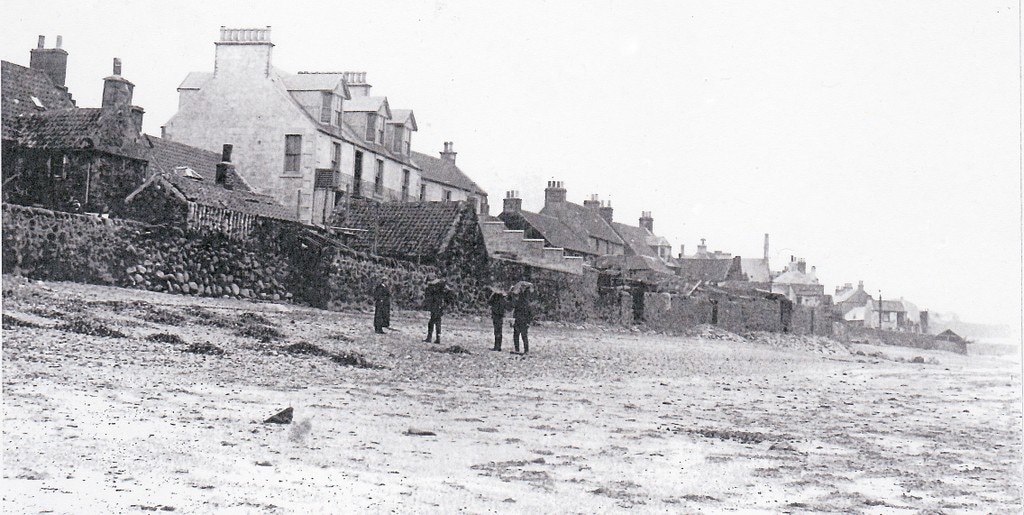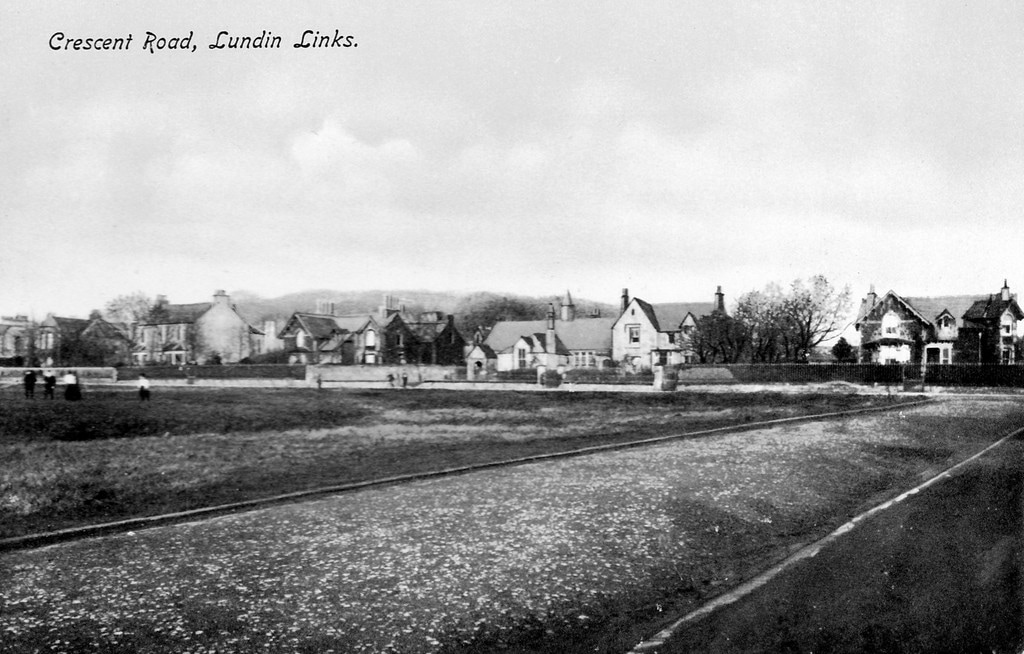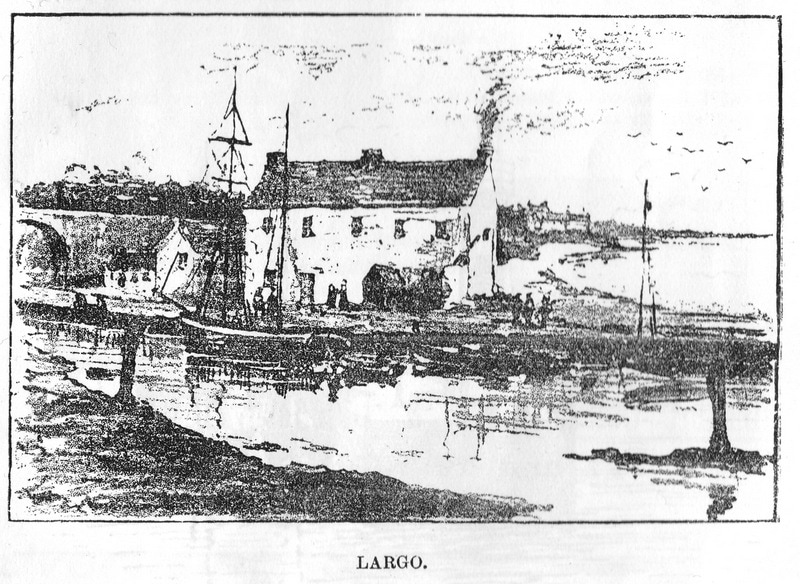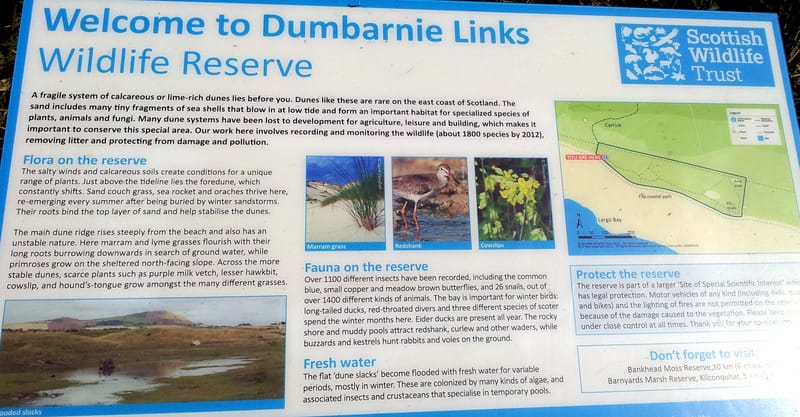|
I have posted the above painting before and in that earlier post queried if this was really Largo and, if so, where. Well mystery is finally solved - one year on. This is the site of what is now Edina View or 'The Barracks'. The photograph from 1885 (by Terras of Markinch) below proves this, as it shows the site when only the eastern half of Edina View had been built and the above old buildings were still there on the west side. Comparing the detail of the two images (see below) we can see that the relative positioning of the old buildings and orientation of the gables ends match up. Half of the crow-stepped building on the left can be seen in the photograph too. The painted image seems so much more important now that its location is confirmed. This is what the seafront just to the east of the Crusoe Hotel looked like around 1880 and probably for a long time beforehand too. An irregular collection of buildings, made from local stone (taken mainly from the beach), very exposed to the sea - these buildings were probably in too poor condition to preserve. Nevertheless, it's a pity they had to go, as they are so full of character. Thankfully, they were captured in paint before the appearance of this stretch of coastline changed forever.
0 Comments
This postcard featuring a section of Crescent Road probably dates to the Edwardian era. The school and school house at are the centre (and in detail below). The school building still has its original two entrances - one for girls (on right) and the other for boys. To its right is Oldfield (originally 'Bayview Cottage') and to the left is Old Calabar (once known as 'Melville Cottage'). Further to the left is 'Elphinstone'. The road in the foreground was for a long time named 'Norvil Road' after the house which lies to the right out of shot - 'Norvil'. This street has since been absorbed into Victoria Road.
The most noticeable change today is that the grassy are on the left has been built on. This whole area - facing onto both Crescent Road and Victoria Road was developed around 1930. The photograph above suggests that, over the seventy years or so that this space was undeveloped, it was used by the school children. They can be seen spilling out of the school and over the road onto the grass. I wonder what activities might have gone on on this open space - sport, drills, fetes, camps, etc? The school (and children) must have felt its loss when finally it was filled with housing. The above postcard image featuring one of the Galloway steam boats at Largo Harbour dates to the 1890s. This was the very end of the era of such visits but offers a striking image of what was once a common sight here. For decades, a number of different steamers had been frequent visitors to Largo, offering pre-railway ferry services and pleasure cruises. The table below lists the main regular callers at Largo - starting with 'Surprise' - a wooden paddle steamer built in 1821, only to be wrecked off Leven early the following year. Four years later 'Victory' took up the Newhaven-Largo route but by 1830 it had competition from 'Rapid'. However, the latter would be as short-lived and unfortunate as 'Surprise'. On 7 April 1831, the Fife Herald reported "Loss of the Rapid Steam-Boat", stating that it was "totally destroyed by fire on the morning of Friday last". This incident occurred off Dysart and the description continued... "The inhabitants were awoke suddenly by the sound of the fire-bell, occasioned by the Rapid steam-boat catching fire in the Roads, opposite the harbour. Her crew were made aware of their danger by the sense of suffocation, and after several vain attempts to extinguish the flames, left her to her fate. The view of the conflagration, as seen from the shore, was awfully grand." Around this time 'St George' became a regular visitor to Largo and would continue to call for around twelve years. Sadly, this boat was involved in a fatal accident at Largo in 1843, when one of her 'florry boats' went down while transferring passengers to the shore. Overlapping in time with 'St George' was 'Ben Ledi' which called at Largo between 1838 and 1846, when she was broken up. Sometimes marketed jointly with 'St George', 'Royal Tar' was another 1840s steamer - completely refitted in 1845 and marketed as "without exception, the swiftest-sailing Steamer crossing the Firth". The late 1840s saw the first visits of iron paddle steamers to Largo - with 'Queen' and 'Fair Trader' but by 1850 visits to Largo seem to have become erratic. In 1854, 'Maid of Leven' was calling here but on 6 July that year the Fife Herald notes that "we are sorry to state that the Maid of Leven steamer has suddenly ceased plying between Largo, Leven, Buckhaven, Dysart, Kirkcaldy and Leith as formerly...much to the disappointment and annoyance of numerous passengers, no notice having been given of the intended stoppage, or the cause of it." Perhaps the customers ought not to have been too surprised, as the railway to Leven opened that summer.
As mentioned in the previous post, the 1880s were the heyday of pleasure steamers. Perhaps by this stage, people had become so accustomed to travelling by rail that the steamers offered a novel and more leisurely mode of transport. And no doubt the levels of safety and comfort had greatly improved since the days of 'Surprise' and 'Rapid'. As the 'Galloway's Tourist Guide' suggests "the tourist in search of enjoyment" and who "naturally is anxious of spending to the best advantage his well-earned holiday" should look no further than their "magnificent new saloon steamer" complete with on-board refreshments. The Galloway Saloon Steam Packet Company were enjoying the heyday of steamer pleasure sailing on the Forth when this tourist guide was produced in 1888. Largo was featured as one of the ports of call - the map below shows services starting at Leith West Pier and taking various routes along both sides of the Forth taking in places of interest. When describing Largo, the guide mentions the "romantic spot" of Kiel's Den, Largo Law, Alexander Selkirk, Sir Andrew Wood and some "remarkable caves" to the east. The image below of Largo Harbour accompanies the description. The sketched picture, while recognisable as Largo, does look curious to me. When placed next to a turn of the century image (further below) of the same view, it is clear that the Crusoe Hotel (onetime granary) is much shorter with fewer windows. It is difficult to be sure what age the sketch is or how accurate it is but seems to be representative in many other respects (as are other sketches in the booklet). Is this how the Crusoe Hotel /granary really looked in the past or is it simply artistic license? Please comment with you views...
A quick 'spot the difference' challenge - two views of Lower Largo Harbour - at least a century and a quarter apart.
Staying largely the same we have:
Key differences (aside from the state of the tide):
Note that the older image must pre-date c1890 as there is no evidence of either the Belmont Hotel nor the second station building at Largo railway station. The latter was built in 1894 when a passing loop was added to the station along with a new platform, building and signal box. Lately I've discovered some excellent aerial video footage of the local area taken using drones. It's great to see a fresh perspective on a familiar place - providing views and angles that you would never normally have access to. For example, some footage shows the viaduct from above. The top of the viaduct represents a route that trains (and people on foot) used to take on a daily basis but that has been long been inaccessible. The ruins of Largo House can been seen from above, giving a very different impression to that achieved on the ground. The route of the railway line can also be followed quite clearly from the air. I have listed some of my favourites from YouTube below - but am sure many more will be added in the future - keep an eye out! If you are a drone videographer - thank you and keep up the great work! Lower Largo - harbour, viaduct, pier: https://www.youtube.com/watch?v=qzAs7feeb20
Lower Largo - winter sunset: https://www.youtube.com/watch?v=D2AlAAb1XuQ Largo House: https://www.youtube.com/watch?v=2osB2zleGTQ Note also that both the Lundin Ladies Golf Club and the Lundin Golf Club have fly-through footage of their courses now. https://www.youtube.com/watch?v=JG9KSC5PkhA https://www.youtube.com/watch?v=t3dR-ShC9aM Enjoy! Leading on from the previous post on Dumbarnie Links, one of the biggest events for this stretch of land was the construction of the railway line along the coast. The Fife Herald, 26 May 1856, notifies readers that "the works will soon be commenced, and will give employment to many workmen, open up new facilities to the trade and commerce of the district, and make the stream-steed career along the pleasant shore of Largo Bay". Of course the prospect of better links into the local area was eagerly anticipated and used as an enticement for people to invest in the area. The advert below is one of many examples where the expected arrival of the railway was mentioned as a benefit.  Progress was fast and by 6 June, the Caledonian Mercury, noted that "the cutting of the first sod on this line is expected to come off in a week or two. Waggons, temporary sleepers, rails, &c having already arrived." The same paper then states on 11 July that "the formation of the East of Fife Railway proceeds rapidly; about one hundred and thirty navvies are employed on its surface. It is considered that in about four months the trains will be running to Largo." While that estimate would prove to be overly optimistic, the mood was upbeat at the October half-yearly meeting of the shareholders. At that point the section of the line between Leven and Largo viaduct was "approaching completion" and "if thought expedient, may be opened for goods traffic in the course of the winter" and perhaps the remaining portion "opened early in the ensuing spring". It was agreed that Mr Thomas Grainger the contractor "deserved every compliment which they could pay him for the energy and success with which he had prosecuted the works, notwithstanding the unfavourable state of the weather and other obstacles". The meeting discussed the urgent need for getting fish traffic from the eastern towns to southern markets more quickly. Another reason for getting part of the line open for goods as soon as possible was to allow the raw materials for the onward construction of the line itself to be brought over land, rather than by sea, as had been the case thus far. Following the meeting, the Directors walked over and inspected the line as far as Largo and were satisifed with progress (23 October Fife Herald). Sadly, soon after this - on 30 October - there was a fatality. A George McKinlay, aged around 45, of Ross-shire, was killed instantly on the site of Largo viaduct. The Dundee Courier ran the story on 5 November, describing how "scaffolding is being put up, the wood of which is being raised by a crane. On the morning in question five "sleepers" were being lifted to the top, when at a height of about forty or fifty feet, the hook at the end of the chain suddenly gave way, and the load was precipitated on the unfortunate man who was passing below at the time for tools for some carpenters on the other side". By January 1857, following an inspection of the line from Leven to Drummochy, it was reported that "it is intended to open this portion of the line for goods traffic on an early day" (22 Jan, Edinburgh Evening Courant). A temporary terminus was created to the west of the uncompleted viaduct, within Drummochy, and the first trains that ran to it apparently caused quite a stir among the locals. Another half-yearly shareholders meeting was reported upon in the 30 April Fife Herald, noting that the line had been open for goods up to Largo since 1 February and that the end of June was the target for the remainder of the line. The meeting also noted that the "traffic in fish was very extensive" and "greater than expectations" and that it was anticipated that trade in agriculture and minerals would be similarly good once the line was fully open. The 7 May Fife Herald noted that the line "was drawing fast towards completion" with most of the track laid, only a few remaining cuttings and embankments to be executed and just "a few stones of the coping and flagging being wanted" to complete the viaduct at Largo. "The station buildings will be proceeded with as soon as the earth cutting necessary to firm their sites has been taken out". The line finally opened on 11 August 1857 - some days after an unofficial opening. One person who recalled the first train making its way across Dumbarnie Links was resident of Dumbarnie farm, Mrs Braid (mother of golfer James). The Courier of 14 October 1925 reported her death but celebrated her long life and many recollections - of the arrival of the railway it stated...
"One bright summer morning her father came running to tell them to come out and see the train puffing and snorting as it made its way slowly along the track from Largo. One can imagine the excitement that the wonderful invention would arouse, and understand too the backwardness of the country folks in not coming forward to take advantage of the free railway ride offered by the railway company on the trial trip." Please note that this blog post was first written in January 2017. On 29 May 2020 a new golf course opened at Dumbarnie - see its website here. Nowadays Dumbarnie Links is known as a wildlife reserve and Site of Special Scientific Interest (SSSI). However, this area has had varied use in the past and its history contains a few surprises. The name of 'Dumbarnie' actually originates in Perthshire (by Bridge of Earn) although the original's name has since morphed into Dunbarney. Back around 1700, a John Craigie, who was Professor of Philosophy at St Andrews University, bought the sourthern part of the Lahill estate east of Kirkton of Largo (once known as Halhill) and named it 'Dumbarnie' after his family's Perthshire estate. Through marriage, the Craigies became the Halkett Craigies, and by 1832, Charles Halkett Craigie was not only laird of 'Hall Hill and Dumbarnie' but also Captain of St Andrews Golf Club. At this time golf was also played on Dumbarnie Links and a sporting club known as 'The Hercules Club' was formed in 1837. On 9 November 1837, the Fife Herald records that the club would meet three times per year - playing twice at Dumbarnie Links and once at Earlsferry. To was also noted that not only did Halkett Craigie allow members the priviledge of playing on the links but he also provided a golf house, a garden and 'every facility afforded for practising' to the 47 members of the club. The Caledonian Mercury of 9 August 1838 states that "The Hercules Club met on Dumbarnie Links on Saturday...to play for the Hume medal, when, after a keen competition, it was won by Charles Halkett Craigie Esq.". In 1841, the Fife Herald of 19 August noted that the Hercules Club had competed for the 'MacDuff medal' on Dumbarnie Links. But the summer of 1845 saw an event on a much larger scale, with the promotion of the 'Colinsburgh Gymnastic Games and Golf Meeting' in the same paper. This event took place on Dumbarnie Links - see details below. The 14 August Fife Herald reported on how the games "came off"... "The day being fine, a vast assemblage of people were on the ground, to the number of six or eight thousand, and the tents pitched for refreshments, with the numerous equipages, gave the scene an altogether a very imposing and gay appearance. An excellent band, provided by the committee, was also in attendance, playing some beautiful airs as a prelude to the various competitions which took place. The place chosen for the purpose is particularly well adapted for such as thing, the games being conducted on the low ground between two low conical hills, the spectators covering the rising ground on both sides of the circle formed for the exhibition." 6,000 to 8,000 people on Dumbarnie Links! I think that is incredible and wish I could have seen such a spectacle. This event pre-dates the arrival of the railway so it can't have been easy for attendees to get to such as rural spot but such was the draw of these sporting games and the lure of the prizes at stake - people came from far and wide. The above description also helps us pinpoint the precise location of the games. The map and image below of the two 'low conical hills' in question (centre of map) are provided by 'Forgotten Greens'. The detailed page on Dumbarnie Links on that site can be viewed here. The article continued to say that the event lasted five or six hours with the excitement maintained throughout. The golf competition saw a Mr Martin of Edinburgh win after two initial rounds of the links then a play off from a field of 18 players. The rifle shooting had 15 competitors, while the general competitions included the running high leap, putting the stone, foot race, throwing the hammer and quoits. Newspaper articles about the Hercules Club and golf competitions on the links continue to appear until 1870 when the 18 Sept Fife Herald notes: “A meeting of the Hercules golf club will be held at the golf-house, Dumbarnie, on Saturday the 17th inst. at 12 o’clock, noon, for the purpose of electing new members and any other business that may be brought before the meeting. Immediately thereafter, the medal belonging to the club will be played for.” By 1872, however, the links were being used for an altogether different purpose. The Fife Rifle Volunteers and Light Horse set up a training encampment at Dumbarnie Links. Numbering several hundred men, the group endured severe thunderstorms and rain coming down in 'bucketfuls' while under canvas - thankfully, the sandy soil drained quickly! Trains stopped at the encampment for its duration and a public holiday was even called on the last Friday to enable locals to visit and see the volunteers turn out. With thanks to Harry Ward and his excellent website forgottengreens.com
|
AboutThis blog is about the history of the villages of Lundin Links, Lower Largo and Upper Largo in Fife, Scotland. Comments and contributions from readers are very welcome!
SearchThere is no in-built search facility on this site. To search for content, go to Google and type your search words followed by "lundin weebly". Categories
All
Archives
July 2024
|























 RSS Feed
RSS Feed
